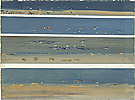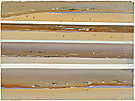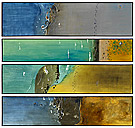Sea Change
Although Fred Williams is best known as a landscape artist, he was also a remarkable painter of water. In the early 1970s his strip gouaches of ocean and beach were a revelation. Conceived in horizontal bands, layer upon layer, like the watercolours of the early nineteenth-century cartographers, they allowed Williams to follow his interest in multiples within a single work.
Williams experimented with the strip format in a number of oil paintings; the wall between each panel approximating the white space of the paper. His oils and gouaches inspired by the Victorian coastline and Erith and Flinders Island in Bass Strait, are among his most innovative works.
In the mid-to-late 1970s Williams’s oil paintings of Mount Kosciusko as well as creeks and riverbeds in the regional countryside, also amounted to a considerable body of work and represent a further major development in his artistic vision.
Williams had painted with gouache on paper since the late 1940s. In contrast to his working method in oils (often painted over long periods) he generally worked fast on his gouaches. By the 1970s he was clearly a master of this medium attaining a remarkable clarity and freshness in his depictions of the environment, intimate studies of fauna and flora and delicate cloudscapes.















